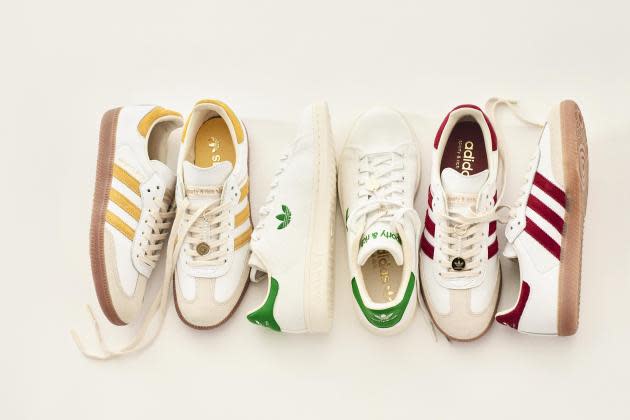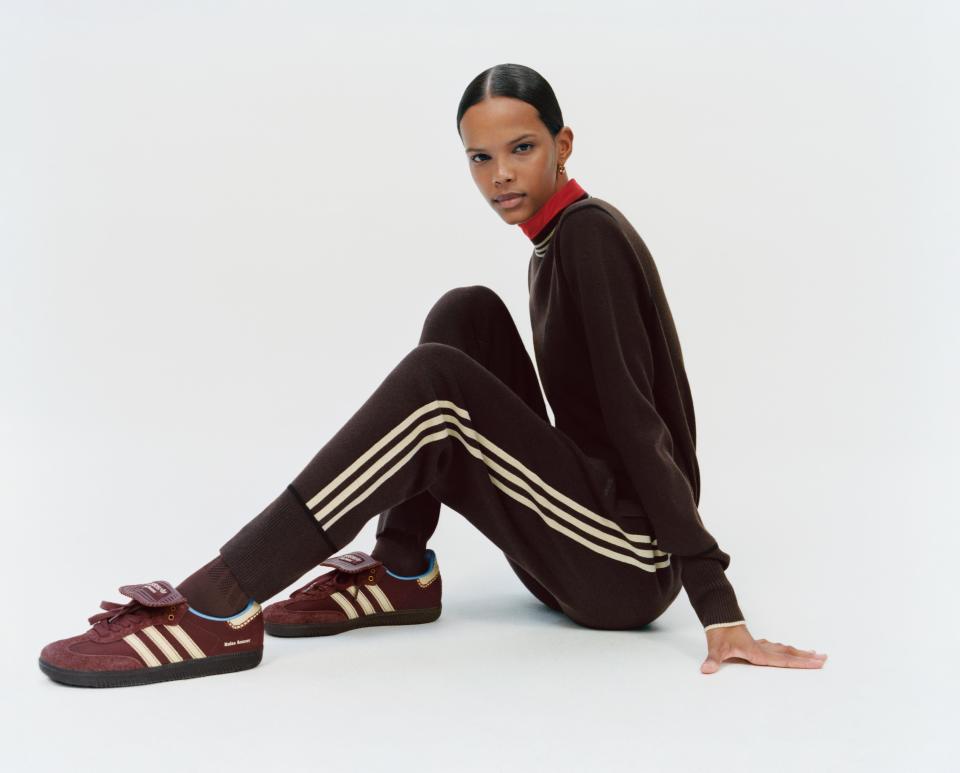Adidas Revenues Up 1% in Q3, Raises Guidance Again

Updated Nov. 8 3:37 p.m. EST
BERLIN — Adidas won’t sell any more leftover Yeezy products this year, the company announced Wednesday. And it hopes to eventually replace the extremely profitable, multiyear collaboration with “many small Yeezys,” as Adidas boss Bjorn Gulden put it.
More from WWD
The announcement came during a press conference announcing Adidas’ third-quarter results, which were slightly better than the company had expected. Adidas just managed to return to growth in the third quarter, reporting a 1 percent increase in sales in currency neutral terms to 5.99 billion euros. Although results were mixed, they were broadly in line with the market’s expectations, analysts noted.
“It’s fair to say we are trending in the right direction although of course, [we are] not as good as we want to be,” Gulden told journalists. The company was becoming more agile and product offerings for winter 2024 — the first under Gulden, who took on the top job in January — had been well received at retail.
“So I really, really believe we are on the way to making Adidas a very successful company again,” Gulden said. He has previously stated he doesn’t expect to see “a good and profitable Adidas” until 2025 at the earliest.
This quarter’s results mean that for the first nine months of the year, Adidas’ growth was flat in currency neutral terms, with revenues of 16.62 billion euros. Last year, the company had made 17.31 billion euros by now.
The sportswear giant is still struggling with the hangover from the end of its extremely lucrative collaboration with the rapper formerly known as Kanye West and the resulting Yeezy line of products. Sector experts have previously suggested the collaboration, which ended in October 2022, could have been making Adidas as much as 1.5 billion euros and around 40 percent of the company’s annual profits, due to the line’s favorable pricing.
But on Wednesday, Adidas executives were keen to show that the company’s core business was doing fine without Yeezy. If the drag from Yeezy products were excluded, then Adidas would actually have grown 2 percent over the third quarter, they boasted.
The brand has been trying to work out what to do with unsold Yeezy product ever since it split from West, after he made racist, antisemitic and other problematic comments. Adidas started selling leftover Yeezy products earlier this year. In the third quarter, these brought in 350 million euros, versus 400 million euros in the prior quarter.
Some of that money will be donated to organizations fighting antisemitism and other forms of prejudice and Gulden hopes the foundation Adidas is creating to disperse the funds will launch by the end of the year. Around 140 million euros have been accrued for donations and some of that has already been donated, the company’s chief financial officer Harm Ohlmeyer noted.
However there would be no more Yeezy drops this year, Gulden also announced. “We’ve done two launches this year pretty quietly. Both were successful,” he said. “But we have decided, for many reasons, not to do any more this year. We will use the next eight to 10 weeks to decide what we will do next. We will evaluate and see what the market reaction is. It’s too early to talk about [what happens] next year.”
In fact, when pressed, Gulden said there might be no more Yeezy drops at all. He also stressed that there were absolutely no plans to work with West again. “What he said was unacceptable,” Gulden added.
The shadow that Yeezy cast over Adidas’ financials has eased somewhat, Ohlmeyer said. At the beginning of 2023, the company had expected its Yeezy problem to lead to a 700 million euro deficit in operating profit by the end of this year. Now it forecasts that this burden will ease, to a 100 million euro deficit in operating profit. More efficient underlying business and the gains from this year’s Yeezy sales were responsible, Ohlmeyer explained.
Gulden agreed there was no way to replace Yeezy but that the German sportswear giant was now pinning its hopes on many “smaller Yeezys.” He reeled off a list of successful collaborations that Adidas was engaged in, including with Moncler, Chinese artist Edison Chen and the Fear of God line that’s expected in the fourth quarter.
“What I mean when I say small Yeezys, is that we will be very active with collaborations, from a creation, design and marketing point of view,” Gulden told WWD. “We believe that with our brand we can find avenues of high demand on higher priced products in the lifestyle area and that we can maybe get that in the performance [product] area.”
Gulden pointed to recent work that designer Stella McCartney had done for Adidas with the women’s team at British soccer club, Arsenal.
Right now though, there was no way of telling if any of those collaborations would ever get big enough to replace Yeezy, Gulden noted.
“Every celebrity and sports star thinks they can be the next Jordan,” he said referring to the success of basketball player Michael Jordan’s work with Adidas rival, Nike. “I am sure people will try and it might happen. But I don’t think you can plan for that. All you can do is work with things that have an impact, which create [brand] heat and consumer interest, and then capitalize on that,” Gulden explained the strategy.
In the third quarter, Adidas saw growth in its largest market, Europe, the Middle East and North Africa. Revenues in the region increased 1.9 percent in currency neutral terms to hit 2.39 billion euros in the third quarter. Adidas has also opened a new office in Saudi Arabia, due in part to that country’s ongoing heavy investment in top-tier sports.
North America was problematic though, with sales there falling 8.8 percent to 1.48 billion euros.

Adidas is dealing with higher inventory levels, and therefore increased discounting, in North America and is trying to reduce the level of goods it has there, the company explained. But there was also consecutive improvement: in the second quarter, sales in North America had fallen 16 percent.
Ohlmeyer told journalists that the company had significantly reduced its overall inventory levels, by 19 percent in currency neutral terms. By Sept. 30, inventory was valued at 4.85 billion euros, down from 6.32 billion euros at the same time in 2022. However, he added, North America was still lagging behind and Adidas did not expect to see levels there go down appropriately for another six months.
To remedy this, Adidas was also trying to get closer to the North American market, Gulden added. A special office opened in Los Angeles earlier in the year, which will be responsible for creating U.S.-specific products. The first of these will start showing up in the second half of next year.
“We will do American street culture where it is created,” Gulden explained. “That’s in L.A., not Herzogenaurach [Adidas’ base in southern Germany]. The big excitement is how we can work more closely with American retailers on a very dedicated process that’s not linked to the European side.”
This means American-created products will likely start to differ more substantially from European lines in the near future, Gulden suggested.
The same is true for other sales territories too, he continued, with products being designed specifically for markets like China and India.
Over the third quarter, every other Adidas sales territory did see growth, including in Greater China, a market that Adidas had previously focused on and which dragged on the company’s ledgers during ongoing pandemic lockdowns in that country. In Greater China, sales rose 5.7 percent in currency neutral terms to 870 million euros.
Moving onto product categories, Adidas said footwear sales, which make up just under two-thirds of total business, rose 6 percent. This included double-digit growth in the Originals category as the so-called “terrace styles” — the Samba, Spezial and Gazelle shoes — become increasingly fashionable with customers.
Accessories revenues were down 3 percent during the quarter and apparel sales also fell 6 percent. This was due to high inventory levels, the company noted. Going into further detail, Adidas said that apparel in its lifestyle category was up slightly, and particularly at the higher-priced end. There the company had seen double-digit growth.
Following the announcement of quarterly results, Adidas raised its guidance again. This is the second time it has done so this year. At the beginning of the year, the sportswear giant said it expected a decline in revenues in the high-single digits for the full year. Given gradual improvements up until now, the company said it now expects declines in the low-single digits.
“We need 2023 to clean up and then we’ll slowly improve in 2024,” Gulden predicted. “During 2025 and 2026 we should be reaching our targets,” he continued. “But If we haven’t reached them by 2026, well then, I probably won’t be in the industry anymore,” he concluded, laughing.
Best of WWD

